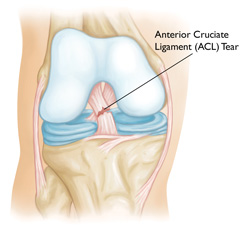An ACL or anterior cruciate ligament injury indicates some damage to one of the ligaments in your knee. Any injury can damage these strong bands of tissue called ligaments. The ACL is the connection between your shinbone and your thighbone. By working with other ligaments, the ACL helps keep your leg bones and knee in place while running or walking. Overstretching can injure the ligament, but it may also be partially or completely torn due to other serious injuries.

Can You Walk with a Torn ACL?
Yes, you can continue to walk after sustaining an ACL injury, but it usually depends on how painful the injury is. If you do not feel severe pain and are in a position to maintain your balance, you can certainly walk. However, it is important to avoid twisting movements while walking with a torn ACL. Your doctor may also advise you to start walking soon after you have recovered from your injury or do not feel serious pain.
In most cases, it is a good idea to talk to your doctor before you start putting pressure on your affected leg. Sometimes, any movement after the injury can cause a small tear to appear in the ligament. This tear may lead to bleeding and your knee may swell too. When this happens, you may feel unbalanced and unsteady. It is better to avoid walking in this situation.
How Do You Know You Have a Torn ACL?
Can you walk with a torn ACL? Yes, you can, but it is better to ask your doctor before bearing weight on your affected leg. It is important to mention that experiencing pain in your knee is not always due to a torn ACL. If it is indeed a torn ACL, you may experience the following as well.
- You may hear a popping sound when you injure your knee. The same popping sound can be noticed when the ACL tears.
- You may experience intense pain, which could be more like a feeling of burning, searing, or intense pain.
- You may develop serious swelling in your injured knee, which may become worse within 5-6 hours of injury.
- You may not be able to bend or straighten your knee after having a torn ACL. Serious ACL injuries make it impossible to put weight on the affected knee.
First Aid for a Torn ACL
Depending on the severity of your injury, you may experience some relief by using some simple home remedies immediately after sustaining an injury. For instance, applying an ice pack to the affected knee may help reduce pain and swelling. You can also use an ACE wrap to help reduce swelling and accelerate recovery.
- For the first 2-3 days, stick to ice only. You should apply ice for 15 minutes, then take a break for 10 minutes and then repeat again. This should continue for 2-3 days to help reduce swelling.
- It is also important to brace the knee after an ACL tear. However, you do not always require it. In fact, depending on how serious your injury is, you may be better off staying away from bracing or immobilizing the knee.
- You may consider using crutches for support. This becomes important if you believe that your knee is not completely stable yet. Crutches will help prevent falls.
In case of a severe injury, it is important to talk to your doctor who will ask for X-rays and other imaging tests to help determine the best treatment option. A swollen knee is usually a good enough indicator that you are dealing with an ACL tear. Still, X-rays help make a better decision, and so do MRIs. An MRI helps determine if you have torn your meniscus as well or if there is any damage done to your articular cartilage as well.
It is important to keep in mind that you should do everything you can to reduce swelling because this helps accelerate recovery. Faster recover ensures less muscle atrophy. In any case, it is a good idea to take advantage of physical therapy to reduce pain and gain strength back in your weak muscles. Even if your doctor has recommended surgery, going for physical therapy may still help you get better results.
